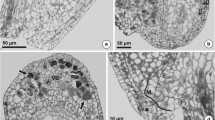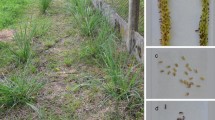Abstract
Meiotic and aposporous embryo sacs and the initial steps of parthenogenetic embryogenesis and endosperm formation were investigated in diploid and tetraploid accessions of Brachiaria decumbens in two environments, differing mainly in day length: early summer and late autumn. Both diploid and tetraploid accessions were facultative apomicts. Di(ha)ploids showed a much lower level of apomixis (10% to15%) than tetraploids (80% to 95%). No obligate sexual diploids were found; thus, their occurrence in natural populations is obscure. It is suggested that reproduction in B. decumbens, as in other agamic complexes of the Paniceae tribe, in general, approximates a diploid-tetraploid-(di)haploid reproductive cycle which does not involve triploids. The dihaploids were fertile and survived in nature. Development of the reproductive structures depended on the environment. In autumn, in contrast to early summer, many meiotic and aposporous embryo sacs degenerated during development, leading to a significant reduction in the proportion of parthenogenetic embryos. Whether this effect can be attributed to day length or simply to age remains to be investigated. The ratio of aposporous to sexual embryo sacs was relatively stable over the two seasons.
Similar content being viewed by others
Author information
Authors and Affiliations
Additional information
Received: 15 April 1998 / Revision accepted: 13 October 1998
Rights and permissions
About this article
Cite this article
Naumova, T., Hayward, M. & Wagenvoort, M. Apomixis and sexuality in diploid and tetraploid accessions of Brachiaria decumbens . Sex Plant Reprod 12, 43–52 (1999). https://doi.org/10.1007/s004970050170
Issue Date:
DOI: https://doi.org/10.1007/s004970050170




